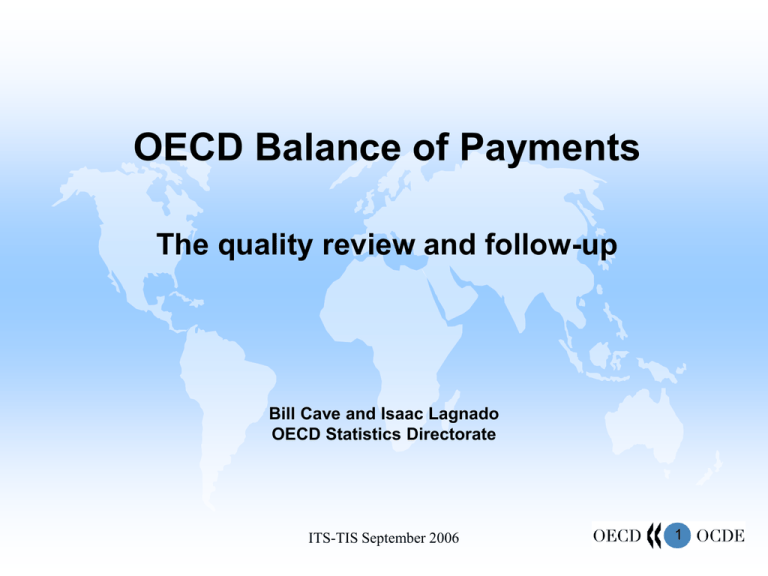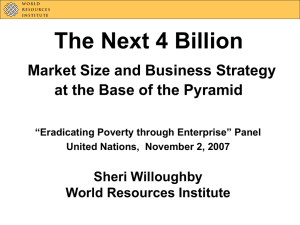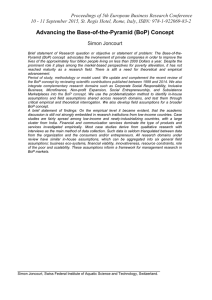OECD Balance of Payments The quality review and follow-up OECD Statistics Directorate
advertisement

OECD Balance of Payments The quality review and follow-up Bill Cave and Isaac Lagnado OECD Statistics Directorate ITS-TIS September 2006 1 Overview OECD Statistics Quality Review of BOP activity 2004 Self-assessment of what we do Users and stakeholders Report 2005 Progress and Follow-up Self-assessment of what we do STD Balance of Payments (BOP) activity is twofold. compilation and maintenance of the BOP Dataset – aims to provide analysts with timely and internationally comparable summary set of BOP data items for OECD (and Big 6) coordination of OECD interests in Balance of Payments (excluding FDI where DAFFE leads) – representation of these in methodological development work of the IMF Balance of Payments Committee Links to Trade in Services, FDI, Merchandise trade, Remittances, National Accounts, Financial Accounts etc Methodological Standards BOP methodological standards set by IMF BOP Manual 5th Edition – now being revised IMF strongly encourages countries to present data according IMF BPM5 standards All OECD countries ostensibly do so But national compilation methods vary e.g. ITRS, Surveys, Customs and Other administrative data Generally good level of international comparability Core Variables collected 1 Current Account B(alance) – – – – 2 Capital Account – B 3 Financial Account – B – – – – – Goods – X, M, B Services – X, M, B Income – Cr, Db, B Current Transfers – B FDI Abroad, FDI in Reporting Economy Portfolio Investment Assets, .. Liabilities Financial derivatives net Other Investment Assets, … Liabilities Change in reserve assets 4 Net Errors and Omissions ITS-TIS September 2006 5 How are data collected? Web Queries SIMS : electronic files or interrogation of National databases Manual entry – seek to minimise Seasonal adjustment of current account series, where countries do not provide(X12 ARIMA using Fame routines) Measures and controls Measures are: – national currency unadjusted and seasonally adjusted (current account only) – US Dollar unadjusted and seasonally adjusted (selected variables only) Data controls – Data capture – series by series historic comparisons – MEI validation controls • CB=G+S+I+T • FA=DI+PI+FD+OI+RA • CB+CAP+FA+NEO=0 Users ECO are our most important user for their economic forecasting and analysis. – Timeliness – Want 24 hour updating during peak periods – Seasonal adjusted data DAF for investment committee or publications – Quarterly data DSTI Detailed annual data General demand for zone totals Main Quality Review Recommendations Develop Zone totals More automatic data collection and improve quality control, and timeliness Review metadata in 2006 Take opportunities to raise the profile of BOP dataset No clear demand for more monthly series Review how to make non-member BOP more coherent Recent Developments in BOP More $ series Zones OECD and G7 Totals for Goods , Services, FDI and G7 Monitoring timeliness – Exhibit A and B Coordination with Non-member BOP – Factbook Newsletter article Proactive discussion with users Zone totals for FDI Flows OECD and G7 FDI flows 1400 1200 1000 OECD outflows OECD inflows $bn 800 600 G7 outflows 400 G7 inflows 200 0 1995 1996 1997 1998 1999 2000 2001 2002 2003 2004 2005 Data dissemination MEI – BOP data are compiled, stored and published in the MEI database. Dissemination simply reflects the case of the MEI database as a whole Press release – Quarterly news release for Trade in Goods and Services OECD.Stat – BOP dataset on OLIS and free subset on Internet Current Plans Review and Revise Metadata by End 2005 Improve timeliness Create new Zone totals – OECD Europe, N America, Asia-Pacific Improve Quality: with SIMS to develop new data preparation and validation area Non-members? The End Thank you for your attention Any comments or questions? ITS-TIS September 2006 14

